| Listing 1 - 10 of 16 | << page >> |
Sort by
|
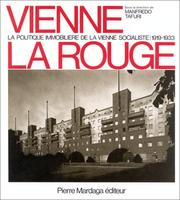
ISBN: 2870091575 9782870091579 Year: 1981 Volume: vol *70 Publisher: Bruxelles Pierre Mardaga Editeur
Abstract | Keywords | Export | Availability | Bookmark
 Loading...
Loading...Choose an application
- Reference Manager
- EndNote
- RefWorks (Direct export to RefWorks)
Le monument socialiste de Vienne la Rouge est le «Hof», le superbloc d'habitations ouvrières qui contient une gamme étendue de services collectifs: écoles gardiennes et primaires, buanderies, cuisines, ateliers artisanaux, espaces verts. Le «Hof» est un modèle d'habitation collective qui ne part pas de l'hypothèse d'une nouvelle organisation urbaine, mais qui s'insère tout naturellement dans les mailles de la ville existante et en accepte toutes les servitudes. Vienne la Rouge ne cherche pas, entre 1919 et 1933, à préfigurer un monde nouveau. Sa diversité ne réside pas dans la réorganisation de l'ensemble métropolitain, mais dans une configuration socialiste de chacune de ses parties. La grande expérience de ces années dans le domaine de la politique de l'habitation s'inscrit comme un moment unique dans l'histoire du mouvement ouvrier. Exceptionnelle est la masse de réflexions théoriques dont s'inspire la politique austro-marxiste, exceptionnels sont les instruments économiques mis en œuvre, exceptionnelles les finalités, exceptionnels les moyens formels qui rendent ce programme de construction visible. Avec l'étude et l'anthologie de Manfredo Tafuri, l'analyse typologique des «Höfe» d'Alfredo Passeri, la chronologie de Paolo Piva, avec sa documentation photographique, cet ouvrage offre une reconstitution fascinante des vicissitudes de la politique de l'habitat dans la Vienne socialiste.
Architecture --- Vienna --- Austria --- architectuur --- architecture [discipline] --- Social policy --- anno 1930-1939 --- anno 1920-1929 --- Autriche --- Bouwkunst --- Geschiedenis van de nieuwste tijden --- Histoire contemporaine --- Immobilier --- Immobiliën --- Oostenrijk --- Socialisme --- Stedenbouw --- Urbanisme --- Dwellings --- Constructivism (Architecture) --- Architecture and state --- Habitations --- Constructivisme (Architecture) --- Politique gouvernementale --- Vienna (Austria) --- Vienne (Autriche) --- Buildings, structures, etc --- Constructions --- Politique sociale --- Patrimoine architectural --- Logement social --- Vienne --- Constructivisme (architecture) --- Politique publique --- Urbanization --- Sociology of environment --- Public administration --- low income housing --- Woonbeleid ; huisvestingsbeleid ; Wenen --- Architectuur en politiek ; Wenen ; socialisme --- Architectuur en politiek ; modernisme en socialisme --- Architectuurkritiek; Italië; Manfredo Tafuri (1935-1994) --- Stedenbouw ; geschiedenis ; Wenen --- 351.77(436) --- Openbaar bestuur ; woonbeleid ; Oostenrijk
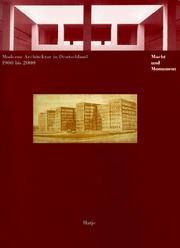
ISBN: 3775707131 Year: 1998 Publisher: Odstfildern-Reut Hatje
Abstract | Keywords | Export | Availability | Bookmark
 Loading...
Loading...Choose an application
- Reference Manager
- EndNote
- RefWorks (Direct export to RefWorks)
architectuur --- architecture [discipline] --- Architecture --- anno 1900-1999 --- Germany --- 72.036 --- Duitsland --- twintigste eeuw --- monumentale architectuur --- architectuur en politiek --- Twintigste eeuw (architectuur) --- 20ste eeuw (architectuur) --- History --- 72.037(430) --- Architectuurgeschiedenis ; 1900 - 1950 ; Duitsland --- 72.038(430) --- Architectuur ; Duitsland ; 20ste eeuw ; 1900-2000 --- Architectuurgeschiedenis ; 1950 - 2000 ; Duitsland
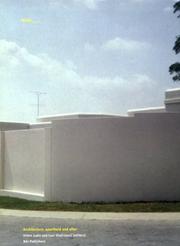
ISBN: 9056620924 0864863942 Year: 1998 Publisher: Rotterdam NAi
Abstract | Keywords | Export | Availability | Bookmark
 Loading...
Loading...Choose an application
- Reference Manager
- EndNote
- RefWorks (Direct export to RefWorks)
Environmental planning --- Politics --- Architecture --- South Africa --- Architectuur en maatschappij --- Architectuur en politiek ; Zuid-Afrika ; apartheid --- 72(680) --- Architectuur ; Zuid-Afrika --- Apartheid --- City planning --- Political aspects --- European influences. --- Architecture, Western (Western countries) --- Building design --- Buildings --- Construction --- Western architecture (Western countries) --- Art --- Building --- Blacks --- Segregation --- European influences --- Design and construction --- Black people --- Architecture, Primitive
Book
ISBN: 9780295987774 0295987774 Year: 2008 Publisher: Seattle University of Washington Press
Abstract | Keywords | Export | Availability | Bookmark
 Loading...
Loading...Choose an application
- Reference Manager
- EndNote
- RefWorks (Direct export to RefWorks)
Architecture and society --- Museum architecture --- Nationalism and architecture --- History --- Architecture --- Architecture and sociology --- Society and architecture --- Sociology and architecture --- Architecture and nationalism --- Nationalism in architecture --- Social aspects --- Human factors --- J0910 --- J6560 --- Japan: Information science and management -- museology --- Japan: Art and antiquities -- architecture -- special classes of buildings --- 727.7(520) --- Architectuur ; Japan ; nationale musea --- Architectuur en politiek --- Gebouwen voor opleiding en wetenschap ; kunstmusea, kunstgalerijen ; Japan
Book
ISBN: 9788887071665 Year: 2016 Publisher: Milano A+mbookstore
Abstract | Keywords | Export | Availability | Bookmark
 Loading...
Loading...Choose an application
- Reference Manager
- EndNote
- RefWorks (Direct export to RefWorks)
Restrictions and tight budgets often lead to some of the most ingenious design solutions and the new House of Memory (Casa della Memoria) in Milan is a case in point. Designed by Italian architecture collective Baukuh, the new building in the rapidly transforming Puorta Nuova area is the city's latest archive, exhibition and conference space. It is fair to say that this project kicked off with a relatively strict budget. ‘It was fixed from the beginning – 3.6 million Euros – and if you think that the building is 2,400 sq m, this leaves a meagre 1500 Euros per sq m to do everything,' says Baukuh co-founder Pier Paolo Tamburelli. ‘This meant exposed concrete structure, exposed installations, pavement in black rubber. All very spartan, but we believe it somehow contributed to the heroic and stoic ethos of the building, somehow reminiscent of early modernist buildings or the Brazilian architecture of the '70s. So, while the exterior references are very local, very Milanese (the local brick tradition dates back to Renaissance), the interior immediately became very brutalist.'
72.07 --- 72.039(450) --- Architectuur ; Milaan ; 2015 ; Casa della Memoria ; Baukuh --- Baukuh ; architectenbureau opgericht door Andrea Zanderigo in 2004 te Milaan --- Architectuur en politiek --- Zanderigo, Andrea °1974 (°Italië) --- Architecten. Stedenbouwkundigen A - Z --- Architectuurgeschiedenis ; 2000 - 2050 ; Italië --- Public architecture. --- Baukuh (Architectural firm). --- Public architecture --- Casa della memoria (Milano, Italy).
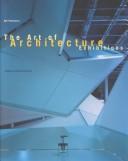

ISBN: 9056622048 9789056622046 Year: 2001 Publisher: Rotterdam NAi
Abstract | Keywords | Export | Availability | Bookmark
 Loading...
Loading...Choose an application
- Reference Manager
- EndNote
- RefWorks (Direct export to RefWorks)
exhibitions [events] --- Building design --- Architecture --- architectural history --- Museology --- Architecture, Modern --- Architectural models --- Modèles architecturaux --- History --- Exhibitions. --- Histoire --- Expositions --- 069 --- 72.078 --- Tentoonstellen ; architectuurtentoonstellingen ; 20ste eeuw --- Libeskind, Daniel --- Architectuur en politiek ; Zuid-Afrika ; apartheid --- Morphosis --- Van den Broek & Bakema --- De Stijl --- Architectuur ; stadia ; sport --- Oud, J.J.P. --- Johnson, Philip --- Tentoonstellingen ; Nederlands Architectuurinstituut (NAI) ; Rotterdam --- Museologie ; museumpresentatie --- 069.53 --- 069.5 --- (069) --- Tentoonstellingsarchitectuur --- Tentoonstellingen (architectuur) --- Architectuurtentoonstellingen --- Museologie ; collecties ; techniek van het tentoonstellen --- Museologie ; collecties --- (Musea. Collecties) --- Modèles architecturaux --- Oud, J.J.P
Book
ISBN: 9782875720023 2875720023 Year: 2013 Volume: 9 Publisher: Bruxelles Atomium/CFC
Abstract | Keywords | Export | Availability | Bookmark
 Loading...
Loading...Choose an application
- Reference Manager
- EndNote
- RefWorks (Direct export to RefWorks)
Les architectes Fernand, Gaston et Maxime Brunfaut ont marqué le 20ème siècle de leur vision progressiste. Emblématiques d'une époque, les réalisations de ce trio visionnaire interpellent l'imaginaire collectif, comme notre regard sur la ville. Avec une belle diversité d'auteurs, ce premier ouvrage à leur être consacré couvre ainsi pas moins de 50 ans de modernisme à Bruxelles et en Belgique.
Brunfaut, Maxime --- Brunfaut, Fernand --- Brunfaut, Gaston --- Architects --- Architecture --- Architectes --- History --- Exhibitions --- Histoire --- Expositions --- Brunfaut, Maxime, --- Modern movement (Architecture) --- Brunfaut, Fernand, --- Brunfaut, Gaston, --- Architecture moderniste --- Mouvement moderne (architecture) --- 72.07 --- Architectuur ; België ; 20ste eeuw ; Brunfaut familie --- Brunfaut, Fernand, Gaston en Maxime --- Brunfaut, Fernand 1886-1972 (°Anseremme, België) --- Brunfaut, Gaston 1894-1974 (°Jemelle, België) --- Brunfaut, Maxime 1909-2003 (°Brussel, belgië) --- Architectuur en engagement --- Architectuur en politiek ; modernisme en socialisme --- Belgische architecten --- Modernistische architectuur --- Tentoonstellingscatalogi ; Brussel ; Atomium --- 72.036 --- België --- Architecten. Stedenbouwkundigen A - Z --- 20ste eeuw (architectuur) --- Modernisme (architectuur) --- Twintigste eeuw (architectuur) --- 20th century --- Belgium --- Brunfaut family --- Exhibitions. --- architects --- Brunfaut, Maxime.
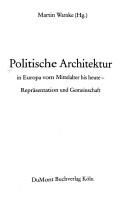
ISBN: 3770115325 Year: 1984 Publisher: Köln DuMont
Abstract | Keywords | Export | Availability | Bookmark
 Loading...
Loading...Choose an application
- Reference Manager
- EndNote
- RefWorks (Direct export to RefWorks)
politics --- political art --- Politics --- Architecture --- architecture [discipline] --- anno 1900-1999 --- Europe --- 72.03 --- 72.01 --- 32 --- Europa --- 725.1 --- 725.12 --- 725.11 --- 725.13 --- 725.94 --- architectuur --- architectuurgeschiedenis --- architectuur en politiek --- politiek --- Rome --- Kapitool --- Renaissance --- Bologna --- Julius II --- paleizen --- allegorieën --- Spaanse Trappen --- Scalinata di Spagna --- Romantiek --- eremonumenten --- Walhalla --- von Klenze Leo --- Speer Albert --- Berlin --- Reichskanzlei --- bruggen --- middeleeuwen --- Groot-Brittannie --- neopalladianisme --- landschapsarchitectuur --- classicisme --- Latrobe Benjamin Henry --- jefferson Thomas --- Washington --- Capitol --- London --- Houses of Parliament --- Behrens Peter --- Sint-Petersburg --- Bonn --- Architectuur (geschiedenis) --- Architectuurgeschiedenis --- Architectuurtheorie --- Architectuur (theorie) --- Politiek --- Openbare gebouwen --- Regeringsgebouwen --- Parlementsgebouwen --- Stadhuizen --- Monumenten --- Public buildings --- Architecture, Modern --- Public buildings.
Book
ISBN: 0297776274 9780297776277 Year: 1980 Publisher: London Weidenfeld
Abstract | Keywords | Export | Availability | Bookmark
 Loading...
Loading...Choose an application
- Reference Manager
- EndNote
- RefWorks (Direct export to RefWorks)
Great Planning Disasters appears as ensational - even a sensationalist - title. But it means what it says. This book deals with a series of great planning decisions - ones costing tens or hundreds or even thousands of millions of pounds or dollars. It analyses the central processes of planning that were involved. And it isolates those which, in the view of many informed people, were disasters either because they were abandoned after much effort, or because they went ahead and were widely criticized as major mistakes. Among the first group-negative disasters - the book looks at London's third airport and the abandoned London motorways. Among the many examples of positive disasters it considers Concorde, the Bay Area Rapid Transit System in San Francisco, and the Sydney Opera House. Lastly it probes two cases of near-disasters that became relative successes: California's plan for new university campuses, and Britain's plans for a new national library in London. From these case studies, in the second part of the book Peter Hall seeks to distil some general lessons. He looks at the role of key actors in the planning process: at community activists, at professional bureaucrats, at the politicians. His analysis, which synthesizes a large body of recent research in politics and related fields of social science, is often unflattering but always illuminating. Finally, drawing again on research-in fields as diverse as long-term future forecasting, welfare economics and ethical philosophy - he offers some tentativesuggestions for improved decision-making in the future.
Economic geography --- City planning --- -Planning --- -711 --- Creation (Literary, artistic, etc.) --- Executive ability --- Management --- Organization --- Cities and towns --- Civic planning --- Land use, Urban --- Model cities --- Redevelopment, Urban --- Slum clearance --- Town planning --- Urban design --- Urban development --- Urban planning --- Land use --- Planning --- Art, Municipal --- Civic improvement --- Regional planning --- Urban policy --- Urban renewal --- Case studies --- Ruimtelijke ordening. Planologie. Stedebouw --- Government policy --- 711 Ruimtelijke ordening. Planologie. Stedebouw --- 711 --- Planification urbaine --- Sydney --- Londres --- Stadsplanning ; inplanting nieuwe architectuur --- Architectuur en politiek --- Architectuurkritiek ; 2de helft 20ste eeuw --- 711.4(A) --- Stedenbouw. Ruimtelijke ordening ; denken over de stedenbouw
Book
ISBN: 9025420281 Year: 1974 Publisher: Amsterdam Contact
Abstract | Keywords | Export | Availability | Bookmark
 Loading...
Loading...Choose an application
- Reference Manager
- EndNote
- RefWorks (Direct export to RefWorks)
Sociology of environment --- Architecture and state --- 72.01 --- 72 --- 72.03 --- 316 --- 3 --- 32 --- Architectuurtheorie ; sociologie ; politiek --- Architectuur en maatschappij --- architectuur --- architectuurtheorie --- architectuurgeschiedenis --- architectuur en politiek --- politiek --- Nederland --- negentiende eeuw --- twintigste eeuw --- architectuurfilosofie --- State and architecture --- Architectuurtheorie. Bouwprincipes. Esthetica van de bouwkunst. Filosofie van de bouwkunst --- Architectuur --- Architectuurgeschiedenis --- Architectuur (geschiedenis) --- Architectuurtheorie --- Architectuur (theorie) --- Sociologie --- Maatschappijwetenschappen --- Politiek --- Architectuur ; theorie, filosofie, esthetica --- architectuur algemeen, architectuurtheorie, wonen --- Architecture and state. --- 72.01 Architectuurtheorie. Bouwprincipes. Esthetica van de bouwkunst. Filosofie van de bouwkunst --- 72.01 Theory and philosophy of architecture. Principles of design, proportion, optical effect --- Theory and philosophy of architecture. Principles of design, proportion, optical effect
| Listing 1 - 10 of 16 | << page >> |
Sort by
|

 Search
Search Feedback
Feedback About UniCat
About UniCat  Help
Help News
News